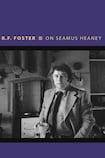
On Seamus Heaney is part of the Princeton University Press Writers on Writers series. Designed to be accessible, the books differ in tone and format from more weighty academic tomes. Foster, the author of a two-volume biography of Yeats, is aware of the challenge of the shorter form and alert to the burden of writing about a poet with whom so many readers have an intimate relationship.
Foster establishes an empathetic framework in the preface, recounting his affinity with particular Heaney poems, relating how “the hairs stood up on his head” when he read North, drawing his circle of readers closer by declaring that Heaney’s work provided a “permanent resource” for readers’ lives.
The book is divided into eight chapters, ranging from the initial “Certus” to the concluding “Clearances”. They trace Heaney’s life chronologically, talking the reader through the volumes that marked Heaney’s poetic oeuvre, attentive to the twists and turns of biography. Heaney’s encounter with “the brilliant Marie Devlin” (“not so much a quarry as a way of life”) relies on notes and testimony from friends. As with other vignettes, Foster paints a lively picture of the couple’s early married life in bohemian Belfast, evoking the animated happenings in the house they lived in on Ashley Avenue.
These pen pictures represent the moments when Foster’s characteristic brio brings Heaney to life again. We encounter them at intervals – describing the Heaneys’ move to Sandymount, Foster relates John McGahern’s comment that Heaney had “bought the coffin”; Oxford life, during the five-year period corresponding to Heaney’s tenure as professor of poetry, is flavoured by Foster’s personal reminiscence, as illustrated by the description of Heaney’s “gown billowing” and his “steady canter” to the podium before delivering lectures.
Archive access
While Foster cannot reinvent the poet’s life and work, his access to the Heaney archive ensures that his book is leavened with new information about key publications and events. The account of the year in Berkeley, for instance, reveals that Heaney dabbled in fiction (never published). Here also, Foster writes fluently of the friendships Heaney formed during that sojourn, detailing their rippling after-effects in Heaney’s later life.
Elsewhere, Foster’s archival scholarship reveals Heaney’s hesitation about the title of North: earlier versions offered “Northerners” or “The North”. Foster comments that the latter “would have flagged up yet more clearly that this was a testament to the part of the island increasingly seen from ‘the South’ as a place apart”. This second chapter is also characterised by Foster’s mustering of the critical forces that were unleashed upon the publication of North. Foster picks his way through the battlefield, dealing bonus points to Edna Longley and Ciaran Carson, admonishing James Simmons, and taking a sideswipe at David Lloyd, who, as a “theoretically sophisticated” critic, should have known better.
Waspish comments like these recur when Foster takes aim at Heaney’s detractors (Simmons and Denis Donoghue), for example, or when he relapses into revisionist mode, such as in the section devoted to Station Island. In that instance, Foster suggests that William Carleton’s short story The Lough Derg Pilgrim “exposes the whole pilgrimage affair as a squalid racket”.
These statements ensure that the book never strays into hagiography; they also remind the reader that this is not a biography but a book in which one writer voices his expert views on another.
For Heaney aficionados, the insight afforded by the notebooks and diaries is invaluable. A long diary entry reveals Heaney’s state of mind as he embarked on Station Island; the notebooks reveal Heaney’s drafting and redrafting of the hunger-striker poem, in the same work, using an image drawn from a dream.
Later Foster explores The Flightpath, referring to its earlier incarnation, published in PN Review (1992); a section, referencing a tipsy autobiographical encounter with British security officials, was dropped from the version published in The Spirit Level. This allows Foster to allude to the twin pressures of public responsibility and personal freedom that were to weigh heavily on Heaney throughout his career, a dialogue in which Heaney engaged with Yeats.
Foster’s knowledge of Yeats’s life and work ensures a close examination of the connections between the poets. For example, Foster demonstrates that Sweeney performs the same function in Heaney’s work as Aedh or Crazy Jane in Yeats’s oeuvre. The commentary on Heaney’s Yeatsian vision of Ireland sheds further light on the concept of bilocation and the preoccupation with national identity explored in the Oxford lectures.
Paroxysm of grief
The concluding chapters are filled with the foreknowledge of the poet’s demise. They outline the chaplet of elegies that mark the final collections. They also share the observations of perceptive friends. Colm Tóibín’s account of Heaney’s appearance at the Kilkenny Arts Festival, for instance, pinpoints a change in stance, an eye on the door. Foster also conveys Heaney’s wry commentary on a late portrait, “It’s more like me than I am.”
In his description of the paroxysm of grief that traversed the nation when Seamus Heaney died, Foster highlights the genuine emotion of a country united in loss. As he states, “Noli timere became Heaney’s final manifesto to the nation and the world, appearing electronically on social media posts and physically on a gable-end wall in Dublin, lovingly repainted and preserved to this day”.
Foster’s concluding paragraphs are devoted to an appraisal of Heaney’s engagement with the role of national poet, underlining the independence and accessibility Heaney came to embody.
During the recent lockdown, the ubiquitous presence of the quotation, “if we can winter this out, we can summer anywhere”, chalked on gable walls and quoted by the taoiseach (not a line from a poem but a quotation from an interview given in 1972), reminds us that Heaney remains a vivid and affirmative presence in the lives of Irish people. On Seamus Heaney, with its fulsome account of his life, its illuminating analysis of his work, and the generous quotations from favourite poems, should find a place in people’s bookshelves all over Ireland and beyond.











